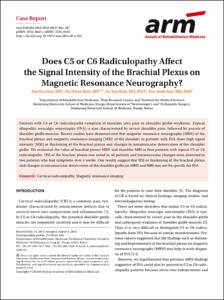KUMEL Repository
1. Journal Papers (연구논문)
1. School of Medicine (의과대학)
Dept. of Rehabilitation Medicine (재활의학)
Does C5 or C6 Radiculopathy Affect the Signal Intensity of the Brachial Plexus on Magnetic Resonance Neurography?
- Keimyung Author(s)
- Kim, Du Hwan; Kim, In Soo; Son, Eun Seok
- Department
- Dept. of Rehabilitation Medicine (재활의학)
Institute for Medical Science (의과학연구소)
Dept. of Neurosurgery (신경외과학)
Dept. of Orthopedic Surgery (정형외과학)
- Journal Title
- Annals of Rehabilitation Medicine
- Issued Date
- 2016
- Volume
- 40
- Issue
- 2
- Abstract
- Patients with C5 or C6 radiculopathy complain of shoulder area pain or shoulder girdle weakness. Typical
idiopathic neuralgic amyotrophy (INA) is also characterized by severe shoulder pain, followed by paresis of
shoulder girdle muscles. Recent studies have demonstrated that magnetic resonance neurography (MRN) of the
brachial plexus and magnetic resonance imaging (MRI) of the shoulder in patients with INA show high signal
intensity (HSI) or thickening of the brachial plexus and changes in intramuscular denervation of the shoulder
girdle. We evaluated the value of brachial plexus MRN and shoulder MRI in four patients with typical C5 or C6
radiculopathy. HSI of the brachial plexus was noted in all patients and intramuscular changes were observed in
two patients who had symptoms over 4 weeks. Our results suggest that HSI or thickening of the brachial plexus
and changes in intramuscular denervation of the shoulder girdle on MRN and MRI may not be specific for INA.
- Publisher
- School of Medicine
- Citation
- Tae Gyu Seo, Du Hwan Kim, In-Soo Kim, Eun Seok Son. (2016). Does C5 or C6 Radiculopathy Affect the Signal Intensity of the Brachial Plexus on Magnetic Resonance Neurography? Annals of Rehabilitation Medicine, 40(2), 362–367. doi: 10.5535/arm.2016.40.2.362
- Type
- Article
- ISSN
- 2234-0645
- 파일 목록
-
-
Download
 oak-2016-0075.pdf
기타 데이터 / 1.14 MB / Adobe PDF
oak-2016-0075.pdf
기타 데이터 / 1.14 MB / Adobe PDF
-
Items in Repository are protected by copyright, with all rights reserved, unless otherwise indicated.